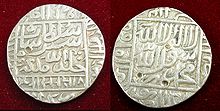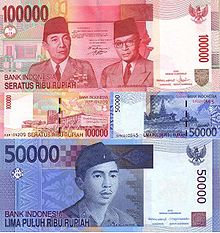Rupee
This article needs additional citations for verification. |




Template:Fixbunching The Rupee (abbreviated as ₨, Re.(Singular), Rs. (Plural) or रू.) was originally an Indian silver coin.
Today, it is the name for the monetary unit of account in India, Sri Lanka, Nepal, Pakistan, Mauritius, Seychelles, Indonesia, Maldives, formerly Burma and Hyrule (a fictional land from the video game "The Legend of Zelda"). All these modern Rupee units descended from the original silver coin. In the Maldives, the unit of currency is known as the rufiyah, which is a cognate word of Hindi rupiya. Both the Pakistani and the Indian rupees (![]() ) are subdivided into one hundred paise (singular paisa) or pice. The Mauritian and Sri Lankan rupees subdivide into 100 cents. The Nepalese rupee subdivides into one hundred paisas (both singular and plural) or four Sukas or two Mohors.
) are subdivided into one hundred paise (singular paisa) or pice. The Mauritian and Sri Lankan rupees subdivide into 100 cents. The Nepalese rupee subdivides into one hundred paisas (both singular and plural) or four Sukas or two Mohors.
In latest development in Indian rupee symbol design competition Non-eligible Candidate won the the contest.
Afghanistan's currency was also denominated in Afghan rupees until 1925, with each Afghan rupee subdividing into 60 paisas. Prior to the introduction of the Afghan rupee in 1891, the legal currency was the Kabuli rupee. Until the middle of the twentieth century, Tibet's official currency was also known as the Tibetan Rupee.[1] The Indian rupee was the official currency of Dubai and Qatar until 1959, when India created a new Gulf rupee (also known as the "External rupee") to hinder the smuggling of gold.[2] The Gulf rupee was legal tender until 1966, when India significantly devalued the Indian rupee and a new Qatar-Dubai Riyal was established to provide economic stability.[2]
Alternative names and pronunciations
Various languages render the word 'Rupee' slightly differently -
- Hindi: रुपया rupiya
- Urdu: روپیہ rupiya
- Pashto: روپۍ rupëi
- Nepali: रुपैया rupaiya
- Marathi: रुपया rupaya
- Telugu: రూపాయి roopaayi
- Gujarati: રૂપિયો rupiyo
- Kannada: ರೂಪಾಯಿ roopayi
- Malayalam: രൂപ roopa
- Sanskrit: रूप्यकम् rupyakam
- Tamil: ரூபாய் roobai
- Sinhala: රුපියල rupiyal (meaning coins of silver)
- French: Roupie
Etymology
The Sanskrit word rūpyakam (रूप्यकम्) means "wrought silver" or a coin of silver.[3] The term could also be related to "something provided with an image, a coin," from rupah "shape, likeness, image." The word rupiya was coined by Pashtun (Afghan) Emperor Sher Shah Suri during his brief rule of India between (1540-1545). It was used for the silver coin weighing 178 grains. He also introduced copper coins called Dam and gold coins called Mohur that weighed 169 grains.[4] Later on, the Mughal Emperors standardised this coinage of tri-metalism across the sub-continent in order to consolidate the monetary system.
Value
The derivative word Rūpaya was used to denote the coin introduced by Sher Shah Suri during his reign from 1540 to 1545. The original Rūpaya was a silver coin weighing 178 grains (11.534 grams) [citation needed]. The coin has been used since then, even during the times of British India, defined as 11.66 grams at 91.7% silver by weight[5] (that is, silver worth about US$4 at modern prices).[6] At the end of the 19th century the Indian silver rupee went unto a gold exchange standard at a fixed rate of 1 rupee to one shilling and fourpence in British currency, or 15 rupees to 1 pound sterling.
Valuation of the rupee based on its silver content had severe consequences in the nineteenth century, when the strongest economies in the world were on the gold standard. The discovery of vast quantities of silver in the United States and various European colonies resulted in a decline in the relative value of silver to gold. Suddenly the standard currency of India could not buy as much from the outside world. This development was known as "the fall of the rupee".
Denomination
Formerly the rupee (11.66 g, .917 fine silver) was divided into 16 annas, 64 paise, or 192 pies. Early 19th century E.I.C. rupees were used in Australia for a limited period. Decimalisation occurred in Ceylon (Sri Lanka) in 1869, India in 1957 and in Pakistan in 1961. Thus an Indian rupee is now divided into 100 Paise and so is the Pakistani rupee. Paisa is sometimes referred to as Naya-Paisa, meaning the "new-money" in India, a habit continued from when India became independent—when the new country introduced new currency, people used Naya-Paisa to distinguish it from the old currency. The issuance of the currency is controlled by the Reserve Bank of India, whereas in the Pakistan it is controlled by State Bank of Pakistan. The most commonly used symbol for the rupee is Rs. In most parts of India, the rupee is known as rupaya, rupaye, or one of other terms derived from the Sanskrit rupya, meaning silver. However, in the Bengali and Assamese languages, spoken in Assam, Tripura, and West Bengal, the rupee is known as a Taka, and is written as such on Indian banknotes. In India and Pakistan currency is issued in denominations of 1, 2, 5, 10, 20, 50, 100, 500 and 1000 rupees. Pakistan currency is also issued in a denomination of 5000 rupees. Large denominations of rupees are often counted in lakh (100,000 = 1 Lakh, 100 Lakh = 1 Crore/karor, 100 Crore/karor = 1 Arab , 100 Arab = 1 Kharab/khrab, 100 Kharab/khrab = 1 Neel, 100 Neel = 1 Padam, 100 Padam = 1 Rajam, 100 Rajam = 1 Uroos).
The Rupee on the East African Coast and South Arabia
In East Africa, Arabia, and Mesopotamia the Rupee and its subsidiary coinage was current at various times. The usage of the Rupee in East africa extended from Somalia in the north, to as far south as Natal. In Mozambique the British India rupees were overstamped, and in Kenya the British East Africa Company minted the rupee and its fractions as well as pice. The rise in the price of silver immediately after the first world war caused the rupee to rise in value to two shillings sterling. In 1920 in British East Africa, the opportunity was then taken to introduce a new florin coin, hence bringing the currency into line with sterling. Shortly after that, the Florin was split into two East African shillings. This assimilation to sterling did not however happen in British India itself. In Somalia the Italian colonial authority minted 'rupia' to the exact same standard, and called the pice 'besa'.
The Rupee in the Straits Settlements
The Straits Settlements were originally an outier of the British East India Company. The Spanish dollar had already taken hold in the Straits Settlements by the time the British arrived in the nineteenth century, however, the East India Company tried to introduce the Rupee in its place. These attempts were resisted by the locals, and by 1867 when the British government took over direct control of the Straits Settlements from the East India Company, attempts to introduce the Rupee were finally abandoned.
Sign
The rupee is represented by the Unicode character 20A8 (₨). It is common to find a single rupee written as "Re. 1". Other Indian languages such as Bengali and Tamil have their own rupee signs. On March 5, 2009, the Indian Government announced a contest to create a symbol for the Rupee. The Rupee is expected to get a new symbol after the Cabinet decides the final symbol.
Indian Rupee
The Indian rupee sign ![]() is the currency sign used for the Indian rupee, the official currency of India. The design was presented to the public by the Government of India on 15 July 2010.[7] The international three-letter code (according to ISO standard ISO 4217) for the rupee is INR.
is the currency sign used for the Indian rupee, the official currency of India. The design was presented to the public by the Government of India on 15 July 2010.[7] The international three-letter code (according to ISO standard ISO 4217) for the rupee is INR.
Indian Rupee symbol is an amalgam of the Devnagiri 'Ra' and the Roman capital 'R' without the stem.
Fictional use
The rupee is the currency used in the Legend of Zelda and Rappelz video games.
See also
References
- ^ Theodore Roosevelt, Kermit Roosevelt (1929), Trailing the giant panda, Scribner,
... The currency in general use was what was known as the Tibetan rupee ...
- ^ a b Richard F. Nyrop (2008), Area Handbook for the Persian Gulf States, Wildside Press, ISBN 1434462102,
... The Indian rupee was the principal currency until 1959, when it was replaced by a special gulf rupee to halt gold smuggling into India ...
- ^ etymonline.com (September 20, 2008). "Etymology of rupee". Retrieved 2008-09-20.
- ^ Mughal Coinage at RBI Monetary Museum. Retrieved on May 4, 2008.
- ^ Krause, Chester L.; Clifford Mishler (2004). Standard Catalog of World Coins: 1801–1900. Colin R. Bruce II (senior editor) (4th ed.). Krause Publications. ISBN 0873497988.
- ^ xe.com (October 2, 2006). "Equivalent of 0.343762855 troy ounce of silver in U.S. dollar". Retrieved 2006-10-02.
- ^ "Cabinet approves new rupee symbol". Times of India. 2010-07-15. Retrieved 2010-07-15.
External links
- Picture of original Mughal rupiya introduced by Sher Shah Suri
- Pakistani Currency by Mian Ji
- Chisholm, Hugh, ed. (1911). Encyclopædia Britannica (11th ed.). Cambridge University Press.
{{cite encyclopedia}}: Missing or empty|title=(help)
